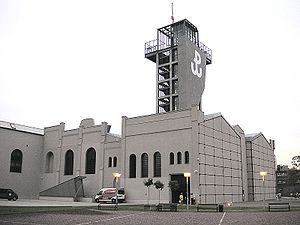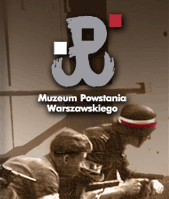
Warsaw Rising Museum
Encyclopedia


Wola
Wola is a district in western Warsaw, Poland, formerly the village of Wielka Wola, incorporated into Warsaw in 1916. An industrial area with traditions reaching back to the early 19th century, it is slowly changing into an office and residential district...
district of Warsaw
Warsaw
Warsaw is the capital and largest city of Poland. It is located on the Vistula River, roughly from the Baltic Sea and from the Carpathian Mountains. Its population in 2010 was estimated at 1,716,855 residents with a greater metropolitan area of 2,631,902 residents, making Warsaw the 10th most...
, Poland
Poland
Poland , officially the Republic of Poland , is a country in Central Europe bordered by Germany to the west; the Czech Republic and Slovakia to the south; Ukraine, Belarus and Lithuania to the east; and the Baltic Sea and Kaliningrad Oblast, a Russian exclave, to the north...
, is a museum
Museum
A museum is an institution that cares for a collection of artifacts and other objects of scientific, artistic, cultural, or historical importance and makes them available for public viewing through exhibits that may be permanent or temporary. Most large museums are located in major cities...
dedicated to the Warsaw Uprising
Warsaw Uprising
The Warsaw Uprising was a major World War II operation by the Polish resistance Home Army , to liberate Warsaw from Nazi Germany. The rebellion was timed to coincide with the Soviet Union's Red Army approaching the eastern suburbs of the city and the retreat of German forces...
of 1944. The institution of the Museum was established in 1983, but no construction work took place for many years, and the museum finally opened on July 31, 2004, marking the 60th anniversary of the Uprising.
The Museum sponsors research into the history of the Uprising, and the history and possessions of the Polish Underground State. It collects and maintains hundreds of artefact
Artifact (archaeology)
An artifact or artefact is "something made or given shape by man, such as a tool or a work of art, esp an object of archaeological interest"...
s, ranging from weapons used by the insurgents to love letters, in order to present a full picture of the people involved. The Museum's stated goals include the creation of an archive of historical information on the Uprising and the recording of the stories and memories of the still living Uprising participants. Its director is Jan Ołdakowski.
The museum is a member organisation of the Platform of European Memory and Conscience
Platform of European Memory and Conscience
The Platform of European Memory and Conscience is an educational project of the European Union bringing together government institutions and organisations from EU countries active in research, documentation, awareness raising and education about the crimes of totalitarian regimes...
.
Exhibitions
The museum is dedicated to all facets of the Warsaw Uprising. Exhibits are full of photographs, written accounts and other testimonies of how life was during 1944. Some sections include:- Children's section: insurgent uniforms, activities, models;
- Hangar; B-24 LiberatorB-24 LiberatorThe Consolidated B-24 Liberator was an American heavy bomber, designed by Consolidated Aircraft of San Diego, California. It was known within the company as the Model 32, and a small number of early models were sold under the name LB-30, for Land Bomber...
: Warsaw airdrops, information videos; - NaziNazismNazism, the common short form name of National Socialism was the ideology and practice of the Nazi Party and of Nazi Germany...
section: German-occupied Poland, sewers; - CommunistCommunismCommunism is a social, political and economic ideology that aims at the establishment of a classless, moneyless, revolutionary and stateless socialist society structured upon common ownership of the means of production...
section: Communist-occupied Poland, puppet government; - Multi-cultural opposition and "Western hesitationWestern betrayalWestern betrayal, also called Yalta betrayal, refers to a range of critical views concerning the foreign policies of several Western countries between approximately 1919 and 1968 regarding Eastern Europe and Central Europe...
": accounts of many ethnicities fighting the Nazis and words of protest from George OrwellGeorge OrwellEric Arthur Blair , better known by his pen name George Orwell, was an English author and journalist...
over the Western hesitation.
Highlights
- A 1:1 replicaReplicaA replica is a copy closely resembling the original concerning its shape and appearance. An inverted replica complements the original by filling its gaps. It can be a copy used for historical purposes, such as being placed in a museum. Sometimes the original never existed. For example, Difference...
of a B-24 Liberator; - A replica of the KubuśKubusThe term Kubu is a Malay exonym ascribed to mobile, animist peoples who live throughout the lowland forests of Southeast Sumatra. In the Malay language, the word Kubu can mean defensive fortification, entrenchment, or a place of refuge...
armoured car; - Contemporary themed cantinaCantinaCantina is a word that can refer to various places and establishments. It is similar in etymology to "canteen", and is derived from the Italian word for a cellar, winery, or vault.Cantinas are found in many towns of Italy...
; - A wall, separate from the main building, known as the heart of the museum and including sounds of battle and heart beats emanating from it;
- Interactive displays with footage and video, creating a high level of immersion;
- A replica of the Palladium Cinema, playing footage taken by the Polish insurgents' own cameramen and originally shown at the original Palladium Cinema in Warsaw during the Uprising;
- A scale model of the Warsaw sewer system;
- A memorialMemorialA memorial is an object which serves as a focus for memory of something, usually a person or an event. Popular forms of memorials include landmark objects or art objects such as sculptures, statues or fountains, and even entire parks....
wall with all the casualties of the Uprising.
External links
- Warsaw Rising Museum (official website)
- Warsaw Rising Museum (original official website)
- Warsaw Rising Museum (Muzeum Powstania Warszawskiego) (Warsaw Tourist Office)

